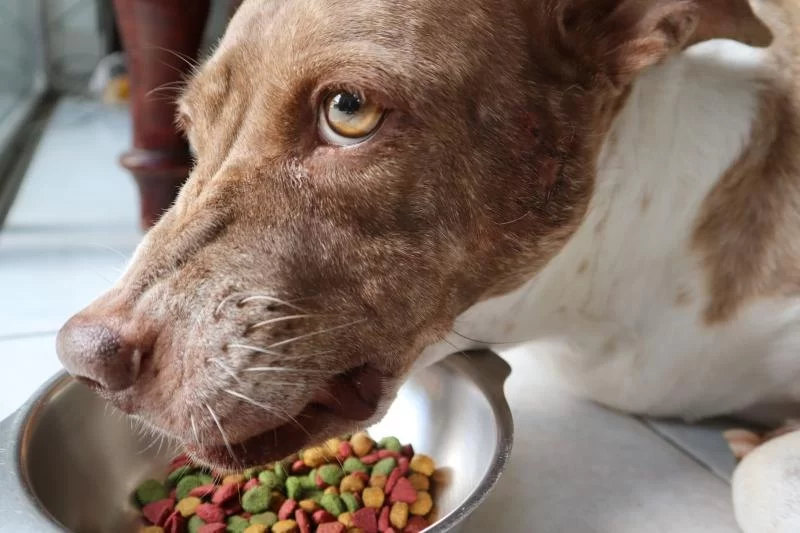- understanding-food-aggression-in-dogs
- signs-your-dog-has-food-aggression
- why-dogs-develop-food-aggression
- how-to-handle-food-aggression-in-dogs-safely
- natural-remedies-to-support-behavior-adjustment
- real-stories-from-pet-owners-and-what-we-learned
- working-with-veterinary-support
1. Understanding Food Aggression in Dogs
Food aggression in dogs is more than just growling at the food bowl—it’s a complex behavior often rooted in anxiety, fear, or resource guarding. It can appear suddenly or slowly over time, and if not addressed correctly, it may worsen or extend to other areas of a dog’s life, like toys or space guarding.
2. Signs Your Dog Has Food Aggression
Food aggression can present in multiple forms: stiff posture, growling, snarling, snapping, or lunging when someone approaches during mealtime. In some cases, dogs freeze and hover over their food. Recognizing these early cues is essential to prevent escalation or potential bites.
3. Why Dogs Develop Food Aggression
Many dogs develop food aggression due to early-life competition, neglect, or traumatic experiences involving food scarcity. Others may develop it later due to underlying medical conditions or pain that makes them feel vulnerable. Understanding the “why” behind food aggression helps guide the “how” when approaching management and care.
For example, a rescue dog who previously had to fight for meals may display intense guarding behaviors, not out of dominance, but survival instinct. Treating this behavior with compassion and patience is critical.
4. How to Handle Food Aggression in Dogs Safely
4.1 Never Punish—Redirect Instead
Punishing a food-aggressive dog will only escalate fear and aggression. Instead, practice positive reinforcement: reward calm behavior near food, gradually desensitize your dog to your presence during feeding, and allow your dog to feel secure and safe.
4.2 Create a Safe Feeding Space
Set up a designated feeding area where your dog isn’t disturbed. Avoid crowding or reaching near your dog during meals. Over time, this consistent calm space helps reduce stress-related guarding.
4.3 Gradual Desensitization
Desensitization involves training your dog to tolerate presence near food. Start by standing a few feet away during feeding and slowly decreasing the distance over weeks, rewarding positive behavior. For many owners, this method has transformed their dog’s feeding experience from hostile to harmonious.
5. Natural Remedies to Support Behavior Adjustment
5.1 Herbal Calming Aids
Chamomile, valerian root, and passionflower have natural calming effects. These herbs, available in chews or drops, help reduce anxiety and hyper-defensive behavior. Always use dog-formulated versions and consult your vet first.
5.2 Aromatherapy and Essential Oils
Lavender and frankincense essential oils can promote a sense of calm when diffused safely in the home. Make sure your dog has an escape route if they dislike the scent, and never apply oils directly unless guided by a professional.
5.3 Diet and Nutrition
A high-quality, balanced diet can positively impact your dog’s behavior. Dogs low in essential fatty acids or with unbalanced gut health can show increased irritability. Omega-3 supplements and probiotic-rich foods may help stabilize mood and improve your dog’s overall well-being.
6. Real Stories from Pet Owners and What We Learned
One client at Hidden Brook Veterinary, Amanda, had a Labrador named Chase who bit her husband during feeding. After assessing Chase’s behavior and diet, they implemented a calming herb regimen alongside desensitization training. Within three months, Chase was eating calmly—even with the family nearby.
Another case involved a rescued Shepherd mix, Luna, who only exhibited food aggression around children. Her behavior was traced back to a traumatic foster environment. Therapy included supervised feedings, child-friendly desensitization games, and emotional support tools. Luna now eats peacefully in a child-friendly household.
7. Working with Veterinary Support
Behavioral aggression tied to food can have underlying medical causes—dental pain, GI issues, or hormonal imbalances. That's why consulting with veterinary experts like those at Hidden Brook Veterinary is so valuable. Our team helps uncover physical contributors and builds holistic, personalized behavior plans that include natural remedies and professional training.
To find out which natural options are safest and effective for your dog’s unique personality, visit Hidden Brook Veterinary. Our care plans are trusted by responsible pet parents and tailored for results you can see—and feel—in your pet’s behavior.












